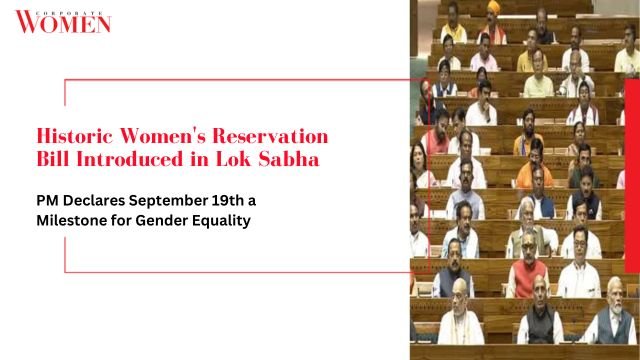Historic Women’s Reservation Bill Introduced in Lok Sabha; PM Declares September 19th a Milestone for Gender Equality

After Three Decades of Delays, the Crucial Legislation Aims to Empower Women in Indian Politics
New Delhi: In a noteworthy development, the Women’s Reservation Bill, designed to secure a 33 per cent quota for women in both the Lok Sabha and state legislative assemblies, was formally presented in the Lok Sabha on September 19th. Prime Minister Narendra Modi heralded this occasion as a “historic day,” underscoring the significance of the long-pending bill officially known as the ‘Nari Shakti Vandan Adhiniyam.’ This legislative milestone, which has languished in the corridors of power for nearly three decades, carries the potential to revolutionise the representation of women in India’s political landscape, potentially elevating the number of women Members of Parliament (MPs) in the Lok Sabha from the current 82 to 181.
Historical Context
Congress leader Adhir Ranjan Chowdhury traced the roots of the Women’s Reservation Bill to his party, highlighting the consistent efforts made by past Congress governments, including those led by Rajiv Gandhi, PV Narasimha Rao, and Manmohan Singh, to champion women’s reservation in politics. Despite securing passage in the Rajya Sabha during the Congress regime under Manmohan Singh, the bill has languished without definitive action.
However, Union Home Minister Amit Shah countered this claim, asserting that the bill had already lapsed. Numerous attempts, political complexities, and enduring setbacks have marked the Women’s Reservation Bill’s journey through India’s legislative history.
Key Provisions of the Women’s Reservation Bill
The Constitution (One Hundred and Twenty-Eighth Amendment) Bill, 2023, introduces pivotal articles and clauses into the Constitution aimed at fostering women’s empowerment in the political arena:
- New Clause in 239AA: This clause mandates reserving seats for women in the Delhi Legislative Assembly. It further stipulates that one-third of the seats allocated for Scheduled Castes (SCs) shall also be reserved for women, alongside one-third of the total seats filled through direct elections.
- New Article – 330A: This article focuses on the reservation of seats for women in the Lok Sabha. It establishes that one-third of the seats designated for SCs and Scheduled Tribes (STs) must also be reserved for women. Additionally, one-third of the total seats filled through direct elections to the Lok Sabha will be reserved for women.
- New Article – 332A: Addressing reserved seats for women in every state Legislative Assembly, this article parallels Article 330A. It mandates that one-third of the seats reserved for SCs and STs shall be reserved for women, along with one-third of the total seats filled through direct elections to the Legislative Assembly.
- New Article – 334A: This article outlines that the reservation shall come into effect after the delimitation process following the publication of relevant figures from the first census. It also establishes a rotation system for seats allocated to women after each subsequent delimitation exercise.
A Long and Complex Journey
The Women’s Reservation Bill’s journey dates back to 1996, when it was initially introduced in the Lok Sabha during the tenure of the Deve Gowda-led United Front government. Despite subsequent attempts in 1998, 1999, 2002, and 2003, the bill faced insurmountable challenges in securing the necessary support for passage.
In 2008, during the UPA government led by Manmohan Singh, the bill succeeded in the Rajya Sabha and was successfully passed in 2010. However, it languished without consideration in the Lok Sabha and ultimately lapsed with the dissolution of the 15th Lok Sabha in 2014.
The current reintroduction of the Women’s Reservation Bill in the Lok Sabha signals a renewed and determined effort to address gender inequality in Indian politics. Its passage could herald a historic transformation in the representation of women in the nation’s legislative bodies. The bill’s journey through the parliamentary process will be closely monitored as it navigates the intricate web of debates and decision-making.
